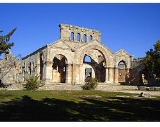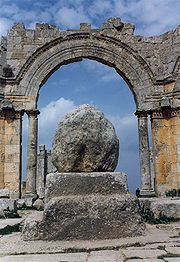
Church of Saint Simeon
Encyclopedia

Aleppo
Aleppo is the largest city in Syria and the capital of Aleppo Governorate, the most populous Syrian governorate. With an official population of 2,301,570 , expanding to over 2.5 million in the metropolitan area, it is also one of the largest cities in the Levant...
, Syria
Syria
Syria , officially the Syrian Arab Republic , is a country in Western Asia, bordering Lebanon and the Mediterranean Sea to the West, Turkey to the north, Iraq to the east, Jordan to the south, and Israel to the southwest....
. The oldest surviving Byzantine church dating back to the 5th century, it is based in the dead city of Telanissos, which is adjacent to the ancient city of Antioch
Antioch
Antioch on the Orontes was an ancient city on the eastern side of the Orontes River. It is near the modern city of Antakya, Turkey.Founded near the end of the 4th century BC by Seleucus I Nicator, one of Alexander the Great's generals, Antioch eventually rivaled Alexandria as the chief city of the...
. Built on the site of the pillar of St. Simeon Stylites
Simeon Stylites
Saint Simeon Stylites or Symeon the Stylite was a Christian ascetic saint who achieved fame because he lived for 39 years on a small platform on top of a pillar near Aleppo in Syria. Several other stylites later followed his model...
, a famed hermit
Hermit
A hermit is a person who lives, to some degree, in seclusion from society.In Christianity, the term was originally applied to a Christian who lives the eremitic life out of a religious conviction, namely the Desert Theology of the Old Testament .In the...
monk, the church is popularly known as either Qalaat Semaan
Semaan
Semaan is one of the oldest Christian surnames in existence and is mainly found in the Levant area of the Middle East...
( ), the 'Fortress of Simeon', or Deir Semaan ( ), the 'Monastery of Simeon' .
History
St. Simeon was born in 386 AD in a village in the Amanus Mountains. He joined a monastery in this area, but soon decided to seek the religious life alone as a hermit monk. After living in a cave for a little while, he relocated to the top of a pillar eventually reaching 15 meters (49 ft) high to achieve greater seclusion. He soon attracted even greater crowds who came from far and near to hear him preach twice a day.After 37 years atop his pillar, St. Simeon died in 459. His body was ceremoniously escorted to Antioch
Antioch
Antioch on the Orontes was an ancient city on the eastern side of the Orontes River. It is near the modern city of Antakya, Turkey.Founded near the end of the 4th century BC by Seleucus I Nicator, one of Alexander the Great's generals, Antioch eventually rivaled Alexandria as the chief city of the...
by seven bishops and several hundred soldiers, followed by a throng of devoted followers. Simeon's grave in Antioch became a major site of pilgrimage, and so did his pillar on the rocky bluff where he had spent the last four decades of his life.
Within just a few decades (c.475), a vast martyrium
Martyrium (architecture)
A martyrium is a structure built at "a site which bears witness to the Christian faith, either by referring to an event in Christ's life or Passion, or by sheltering the grave of a martyr"....
was built in Simeon's honor on this site. It consisted of four basilicas radiating from the sides of a central octagon, within which was enshrined the famous column.
The 5,000 square meters (53,820 sq; ft) of floor space was nearly equal to that of the Hagia Sophia
Hagia Sophia
Hagia Sophia is a former Orthodox patriarchal basilica, later a mosque, and now a museum in Istanbul, Turkey...
in Constantinople
Constantinople
Constantinople was the capital of the Roman, Eastern Roman, Byzantine, Latin, and Ottoman Empires. Throughout most of the Middle Ages, Constantinople was Europe's largest and wealthiest city.-Names:...
. Yet, quite unlike Hagia Sophia, the Church of St. Simeon was (and is) perched atop a barren hill 60 km (37 mi) from the nearest city. But it was not isolated: the church was only one part of a huge, walled complex that included a monastery, two lesser churches, and several large hostels.
Current status
St. Simeon's pillar can still be seen in the center of the courtyard, although it is now only a 2 meter (6 ft 7 in) high boulder due to centuries of relic-gathering by pilgrims. The courtyard is surrounded by four basilicas on a cruciform plan.The east basilica is slightly larger than the others; it was the most important and held all the major ceremonies. Adjacent to the south wall of the eastern basilica is the chapel and the monastery.
Opposite the southern basilica is the baptistery, which was built a little after the main church but is an important part of the pilgrimage complex. To the west of the baptistery is the processional route that leads towards Deir Semaan
Semaan
Semaan is one of the oldest Christian surnames in existence and is mainly found in the Levant area of the Middle East...
.
As of June 2011, the Church and surrounding village was designated by United Nations Educational, Scientific and Cultural Organization (UNESCO) as part of the "Ancient Villages of Northern Syria", a World Heritage Site.

